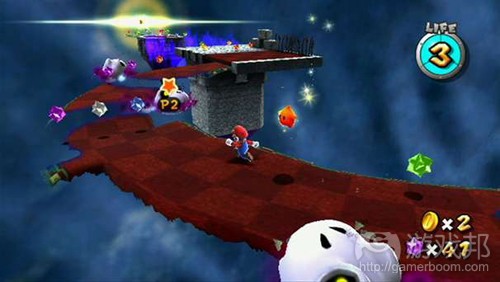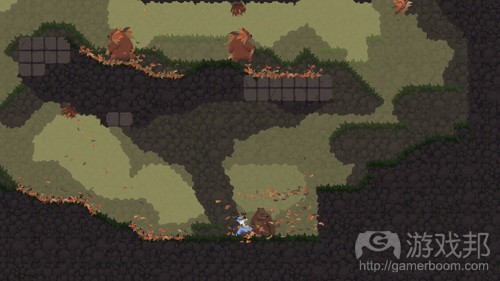举例阐述平台游戏跳跃机制设计原理
作者:Josh Bycer
平台游戏是游戏行业中最古老的一种游戏类型。尽管人们都认为这是最简单的一种游戏,但是其中也隐藏着许多需要考虑的因素。
在最近对《无风的山谷》分析中,我谈到了如今的平台游戏不再像我们过去喜欢的游戏那般精细了。而当我深入思考时,我也开始好奇为何某些平台游戏会优于其它游戏?为何《超级马里奥》与《超级马里奥银河》一样备受瞩目?为何在《刺客信条》中穿越屋顶而奔跑跳跃或在《Crackdown》中追踪技能魔法球能够让我们激动?
平台游戏一直都是我很喜欢的游戏类型之一。《超级马里奥》是我在1988年玩过的第一款电子游戏。如今平台游戏已经从2D进化到了3D,而随着《Explosion Man》和《超级食肉男孩》等游戏的发行,我们又看到了2D游戏的复苏。
当提到平台游戏设计(不管是2D还是3D)时,我们必须明确3个元素:地面行动,天上行动以及最终环境本身。过去几年的不同平台游戏也都相应地体现了这3个元素。
尽全力快速奔跑
让我们先从地面说起,因为它是3个元素中最简单的。这是赋予游戏角色一定“重量”的最简单方法。你是否还记得在最初的《超级马里奥》中,马里奥如果是站着跳跃便不可能跳得多远,而如果他是奔跑着跳跃的话情况也就不一样了。当提到地面移动时我们需要考虑到两个设计原理。
首先移动都是基于锁定速度:行走和奔跑。当玩家按压某个按键或推动操纵杆时,角色将基于一定的速度而移动。按压调节器按钮将让角色奔跑起来,并且也是基于同一个速度。游戏中并不存在中间速度,要么玩家就是停止不动,要么他就是以行走或奔跑速度而前行。
其次便是使用渐进系统。比起只是基于一两种锁定速度前行,玩家在此将拥有更多的控制权。在这一系统中有两个极端条件:静止或全速奔跑,并且是根据玩家控制操纵杆的力度而决定速度。轻轻推动操纵杆玩家便能够行走,而慢慢加大力度的话他们的移动速度也将逐渐加快。如果是尽全力推动操纵杆,玩家便能够奔跑起来。
随着操纵杆的逐渐普及,这种渐进系统也被广泛应用于许多3D游戏中。而一些2D游戏(如《超级食肉男孩》)也使用了这种机制——为了更好地体现出挑战水平和控制。而另一种结果便是按钮控件将不再适合控制行动,因为按钮的控制水平远远不及操纵杆。而这也将大大提高游戏难度,那些使用键盘玩《超级食肉男孩》的玩家便能够证实这一点。
哪个原理更有效——如果在游戏中移动更重要的话那我们便应该选择渐进系统;而如果游戏挑战主要是跳跃而不是地面移动的话,那么锁定速度将会更有效。
腾空时间
接下来我们将说说天上会发生什么。可能发生于空中的行动远远多于在地上。例如在《马里奥银河》中,玩家可以通过5种以上的方法进行跳跃并以此创造出不同的距离和高度。
早前基本上没有什么空中控制方式的设计。也就意味着尽管你按压了跳跃按钮也不会对角色造成任何影响,直到他们降落或死亡为止。这便是为何我们会认为早前的游戏很困难的主要原因——玩家如果想要获得生存就必须采取最精确的行动。当主机进入16位时代后,这种设计类型也不再有效,取而代之的是玩家将能够控制角色在半空中的行动了。
另外一个产生极大影响的主要设计决策便是让玩家能够悬挂在平台上。而这将会影响关卡的设计,设计师将拥有更广的空间去创造跳跃,并超越角色的跳跃限制让他们能够按照自己的想法而跳跃。在这里抓住平台边缘地区所存在的问题便是,作为设计师的你必须想法让玩家能够点击他们想要激活的平台而到达任何点上。
在围绕着快速移动或计时玩法的游戏中,抓住边缘将给我们惹来更多麻烦。因为抓住边缘机制总是自动的,而在掉落的同时抓住平台边缘将耗费宝贵的时间。而这种机制也只能驱使玩家不断训练自己的技能,并影响玩家精通游戏的过程。
如果你希望玩家能够专注于精确的跳跃并尽可能地快速移动,那么抓住边缘这种安全网便可能阻碍玩家学习如何跳跃。举个例子来说吧:《超级食肉男孩》中的许多关卡都要求玩家不断地跳跃或蹬壁上墙。而如果玩家停下来并抓住某个边缘,他便不能创造一股冲力去穿越更复杂的关卡。
深受设计师们青睐的其它空中运动还包括二段跳,蹬壁上墙以及空中疾奔。这些移动并不会使平台游戏更加繁琐,而是将进一步整合到玩家的行动中。因为没有人会愿意玩一款角色将在空中无限跳跃的游戏,这该多无聊啊。
这些移动既不会简化挑战,也能够帮助玩家到达他们心中的目的地。这便是为何早前的开发者会频繁地使用额外移动去设置隐藏区域或可选择路径的主要原因。这既能让新手玩家无需担心高级机制而顺利地穿越游戏,同时也奖励了掌握这些机制的资深玩家。
从A点到B点
最后,如果游戏环境不能提供合适的挑战,那么不管玩家如何在地面还是空中移动也都没有任何意义。平台游戏的关卡设计所面临的一大难题便在于关卡设计与玩家动作设定间的平衡。基本要素并不是设置陷阱或超越机制范围的挑战——如设置让玩家难以跃过的凹点。
良好的环境设计应该像谜题一样。玩家待在X,而他需要基于自己的方式到达Y或Z。对于那些建立在多种机制基础上的游戏来说,最好先使用一些基本机制去挑战玩家,并将较为高级的机制作为侧选项或可选择元素。尽管之后这些较复杂的机制将成为标准机制,但是到那时候玩家也应该掌握了游戏的基本元素了。我们可以在《超级马里奥银河》以及《Dust Force》等游戏中看到这一原理,并且这也是我在主观难度文章中提到的绝佳典例。
探索环境的刺激感与现实世界中跑酷(游戏邦注:一种极限运动)所带来的感受其实是相同的。平台游戏的乐趣并不是关于玩家在空中不断跳跃直到到达目的地,而是玩家任意使用各种道具和能力并最终获取成功。这也是为何像《Crackdown》和《刺客信条》等游戏在运动方面表现得如此出色的主要原因。
《Crackdown》更是将环境转变成谜题一样的存在。整个城市遍布着灵活的魔法球,而玩家便需要想出各种方法去获得它们并爬上不同的建筑。当玩家穿越每个区域时,建筑物也将随着玩家敏捷度的提高而越变越高。
在《刺客信条》系列中,游戏主要是关于创造一个恒定的移动状态。玩家将能够通过墙壁爬上每一个裂缝或凸出的峭壁,从而到达不同城市的不同点。而对于《刺客信条》我认为唯一存在的问题便是设计师未能像《Crackdown》那样围绕着这一设计创造挑战和不同的探索元素。
我希望看到其他设计师也能采取跑酷的理念并将其转变成游戏元素,就像《滑板》系列便尝试着将现实中的滑板运动融入游戏中。相对其它游戏类型平台游戏更为简单,因为它主要关注于游戏中的移动。而这种简单性便能够创造出更多类型的游戏,包括操作简单的《超级马里奥银河》系列以及具有一定挑战的《超级食肉男孩》,《Dust Force》等在任何时间任何空间都非常有趣的平台游戏。(本文为游戏邦/gamerboom.com编译,拒绝任何不保留版权的转载,如需转载请联系:游戏邦)
The Art of the Platformer
by Josh Bycer
The platformer genre is one of the oldest ones in the industry. Even though it may be considered one of the simplest, there are a lot of factors under the hood to consider.
In my recent analysis of A Valley Without Wind, I talked about how the platforming gameplay didn’t feel as refined as I would have liked. As I thought about it more, I started to think about why certain platformers fared better than others. Why is Super Mario Brothers as highly regarded as Super Mario Galaxy? Why do we get such a thrill running and jumping across rooftops in Assassin’s Creed or going after skill orbs in Crackdown?
Platformers are up there as one of my most played genres of all time. Super Mario Brothers was the first video game I played back in 1988. Platformers have evolved from the 2D era to 3D, then in a strange situation found resurgence with 2D again with titles like Explosion Man and Super Meat Boy.
Super Mario Galaxy
When it comes to platformer design, either 2d or 3d, there are three elements to examine: on the ground action, what you can do in the air and finally the environment itself. Different platformers over the years, each have their own take on these three aspects.
Run, Run as Fast As you can…
Let’s start with the ground as it is the simplest of the three. This is simply the act of giving the character “weight” in the world. If you remember in the original Super Mario Brothers, Mario would never jump as far when standing in a stationary position as oppose to running before leaping. When it comes to ground movement, there are two design philosophies that are followed.
First is movement being based on locked speeds: walking and running. When the player pushes either the key or analog stick, the character will move at one speed constantly. Pressing a modifier button will cause the character to run, which also has one speed. There is no in between, either the player is not moving, at walking speed, or at running speed.
The second type is using a gradual system. Instead of using one or two locked speeds, the player has more control over it. In this system, there are two extremes: stopped and full on running. Depending on how far the player moves the analog stick, determines their speed between the two. Push the stick a little bit, and the player walks, a little more and they move quicker. Push the stick as far it will go and the player runs.
The gradual system has become adopted primarily by 3D titles as it coincided with the analog stick becoming popularized. However some 2D titles like Super Meat Boy also use this, due to the challenge level and need for greater control. The other consequence is that it made button control for movement not applicable due to not having the level of control with a button compared to an analog stick. This can increase the difficulty of a game dramatically, which anyone who played Super Meat Boy using a keyboard could attest to.
Super Meat Boy
In terms of which one is better, the gradual system is used more when movement is more important. However, if the challenge of the game is making tricky jumps and not about ground movement, then the lock speeds can work.
Hang Time:
Next up let’s talk about what happens in the air. The amount of possible actions in mid-air are far greater compared to the ground. For instance, in Mario Galaxy, players have more than 5 different ways to jump that affect distance and height.
In the past, the original design of air control was that there was none. Meaning that once you hit the jump button that was it, and you could not affect the character until they land or died. This kind of control was one of the reasons why a lot of early games were so difficult due to the precise actions needed to survive. As consoles entered the 16 bit era and beyond, this type of design was mostly replaced by allowing the player to control characters in mid air.
Another major design decision that changed the design dramatically was the option to allow the player to hang from ledges. This affected how the level was designed, as it gave the designer the luxury to create leaps that were beyond the character’s jumping limit forcing them to make leaps of faith. The problem with edge holding is that as a designer, you have to prepare for the player to try to reach any point by trying to hit the exact point on the ledge that’s needed to activate it.
In games designed around fast movement or time trial style gameplay, edge holding can be more trouble than it’s worth. The reason is that the mechanic of edge holding is always automatic and automatically hanging on to edges when dropping will cost precious seconds. Also the mechanic can be viewed as training wheels and hurt learning the game.
Assassin’s Creed
If you want the player to focus on making precise jumps and moving as quickly as possible, the safety net of holding onto edges can prevent players from learning about making those jumps. As an example: many of Super Meat Boy’s levels rely on the player having a constant momentum to make the jumps or wall run safely. If the player would constantly stop to grab a hold of edges, they would not be able to build the momentum needed to get through the harder levels.
Other aerial movements that have become popular among designers are double jumping, wall running and air dashing. The point about these additional moves isn’t to trivialize the platforming but to be integrated into the player’s actions. No one wants to play a platformer where the character has infinite mid-air jumps as that would be boring.
These moves should be used to help the player get to where they want to go, not trivialize the challenge. This is why setting up hidden areas or alternate paths using additional moves is a popular past time. As it allows novice players to get through without having to worry about advance mechanics, while rewarding expert players for learning the mechanics.
Going From Point A to Point B
Lastly, how the player moves on the ground and in the air can be all for moot if the environment doesn’t provide an adequate challenge. The difficulty when it comes to platformer level design, is balancing out the design of the levels with the move-set given to the player. The basics would be not setting up traps or challenges beyond the scope of the mechanics, like pits that are longer then the player can jump.
Good environmental design should be almost puzzle like. The player is at X, and they need to get to Y, with the world or Z in their way. For games built around multiple mechanics, it’s always good to challenge the player with the basic mechanics first, while having advanced mechanics as side options or alternate routes. Eventually those harder mechanics will become standard but by then, the player should have a grasp of the basics. That philosophy can be seen in titles like Super Mario Galaxy and Dust Force, and are a good example of subjective difficulty from my article.
DustForce
The thrill of exploring the environment has a real world equivalent in the sport of Parkour. The joy of playing platformers is not about infinitely jumping in mid-air until you reach the end, but about using the tools and abilities at your disposal to succeed. This feeling is why games like Crackdown and Assassin’s Creed worked so well in regards to movement.
Crackdown was more about turning the environment into a puzzle. With agility orbs placed all throughout the city, the player would have to figure out the best way to reach them along with climbing up the different buildings. As the player moved through each district, the buildings became taller to match with the player improving their agility.
In the Assassin’s Creed series, the game was about creating a constant state of movement. Players were able to climb up almost every crack or edge protruding from a wall to allow them to reach almost every point in the different cities. My only problem with AC is that the designers never took this design and made challenges and different exploration elements around it to the same degree as Crackdown.
I would love to see someone take the idea of Parkour and translate it to a game, similar to how the Skate series attempted a more realistic gameplay with skateboarding. The platforming genre may seem simple compared to other genres due to its focus on movement above all else. But its simplicity allows for a wide variety of games, from the accessible Super Mario Galaxy series, to challenging titles like Super Meat Boy, Dust Force and what could be the greatest platformer in all of time and space.(source:GAMASUTRA)












































